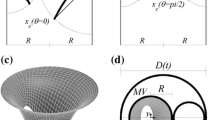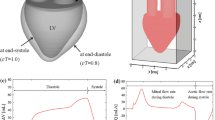Abstract
This study was aimed at developing a physical model, supported by experimental observations, to describe the formation and growth of microbubbles seen in patients with mitral mechanical heart valves (MHV). This phenomenon, often referred to as high intensity transient signals (HITS), appears as bright, intense, high-velocity and persistent echoes detected by Doppler ultrasonography at the instant of closure. The long-term clinical implications of HITS has yet to be determined. However, there are reports of a certain degree of neurological disorder in patients with mitral MHV. The numerical analysis has shown the existence of a twofold process (1) nucleation and (2) microbubble growth as a result of cavitation. While mild growth of nuclei is governed by diffusion, explosive growth of microbubbles is controlled by pressure drop on the atrial side of mitral MHV. It was demonstrated that there exist limits on both microbubble size and regurgitant velocity, above which microbubbles grow explosively, and below which growth is almost nonexistent. Therefore, prevention of excessive pressure drops induced by high closing velocities related to the dynamics of closure of mitral MHV may offer design changes in the future generations of mechanical valves. © 1999 Biomedical Engineering Society.
PAC99: 8763Df, 8710+e, 8719Uv, 8780Rb, 4755Dz, 8719La
Similar content being viewed by others
REFERENCES
Biancucci, B. A., S. Deutsch, D. B. Geselowitz, and J. M. Tarbell. In vitro studies of gas bubble formation by mechanical heart valves. J. Heart Valve Dis. 8:186–196, 1999.
Bluestein, D., S. Einav, and N. H. C. Hwang. A squeeze flow phenomenon at the closing of a bileaflet mechanical valve prosthesis. J. Biomech. 27:1369–1378, 1994.
Brennen, C. E. Cavitation and bubble dynamics. New York: Oxford University Press, 1995.
Byrne, J. P., D. M. Behrendt, M. M. Kirsh, and M. B. Orringer. Replacement of heart valves by prosthetic devices. Pathobiology 7:83–114, 1977.
Cape, E. C., E. G. Skoufis, A. E. Weyman, A. P. Yoganathan, and R. A. Levin. A new method for noninvasive quantification of valvular regurgitation based on conservation of momentum: in-vitro validation. Circulation 79:1343–1353, 1989.
Chahine, G. L. Bubble interactions with vortices. In: Fluid Vortices, edited by S. I. Green. Dordrecht: Kluwer Academic, 1995, pp. 783–828.
Dauzat, M., G. Deklunder, A. Aldis, M. Rabinovitch, F. Burte, and P. M. Bret. Gas bubble emboli detected by transcranial Doppler sonography in patients with prosthetic heart valves: a preliminary report. J. Ultrasound Med. 13:129–135, 1994.
Dellsperger, K. C., D. W. Wieting, D. A. Baehr, R. J. Bard, J. Brugger, and E. C. Harrison. Regurgitation of prosthetic heart valves: dependence on heart rate and cardiac output. Am. J. Cardiol. 51:321–328, 1983.
Diebold, B., A. Delouche, P. Delouche, J. P. Guglielmi, P. Dumee, and A. Herment. In-vitro flow mapping of regurgitant jets: systematic description of free jet with laser Doppler velocimetry. Circulation 94:158–169, 1996.
Emery, R. W., E. Mettler, and D. M. Nicoloff. A new cardiac prosthesis: the St. Jude Medical cardiac valve: in-vivo results. Circulation 60:48–54, 1979.
Georgiadis, D., R. W. Baumgartner, R. Karatschai, A. Lindner, and H. R. Zerkowski: Further evidence of gaseous embolic material in patients with artificial heart valves. J. Thorac. Cardiovasc. Surg. 115:808–810, 1998.
Georgiadis, D., A. Wenzel, D. Lehmann, A. Lindner, H. R. Zerkowski, S. Zierz, and M. P. Spencer. Influence of oxygen ventilation on Doppler microembolic signals in patients with artificial heart valves. Stroke 28:2189–2194, 1997.
Graf, T., H. Fischer, H. Reul, and G. Rau. Cavitation potential of mechanical heart valve prosthesis. Int. J. Artif. Organs 14:169–174, 1991.
Graf, T., H. Reul, D. Wolfgang, R. Wilmes, and G. Rau. Cavitation of mechanical heart valves under physiologic conditions. J. Heart Valve Dis. 1:131–141, 1992.
Green, S. I. Introduction to vorticity. In: Fluid Vortices, edited by S. I. Green. Dordrecht: Kluwer Academic, 1995, pp. 1–34.
Guo, G. X., C. C. Xu, and N. H. C. Hwang. Laser assessment of leaflet closing motion in prosthetic heart valves. J. Biomed. Eng. 12:477–481, 1990.
Hall, K. V., R. L. Kaster, and A. Woien. An improved pivotal disc-type prosthetic heart valve. J. Oslo City Hosp. 29:3–21, 1979.
Hwang, N. H. C., R. S. Meltzer, M. A. Moehring, J. D. Thomas, B. F. Vanderberg, and A. P. Yoganathan. Spontaneous echo contrast in patients with mechanical heart valve implants. Panel Summary-J. Am. Soc. Artif. Inter. Organs. 42:24–26, 1996.
Kafesjian, R., M. Howanec, G. D. Ward, L. Diep, L. S. Wagstaff, and R. Rhee. Cavitation damage of Pyrolytic carbon in mechanical heart valves. J. Heart Valve Dis. 3:S2-S7, 1994.
Kingsbury, C., R. Kafesjian, G. Guo, P. Adlparvar, J. Unger, R. C. Quijano, T. Graf, H. Fisher, H. Reul, and G. Rau. Cavitation threshold with respect to dP/dt: evaluation in 29 mm bileaflet, Pyrolytic carbon heart valves. Int. J. Artif. Organs 16:515–520, 1993.
Kort, A. and I. Kronzon. Microbubble formation: in-vitro and in-vivo observation. J. Clin. Ultrasound 10:117–120, 1982.
Levy, D. J., J. S. Child, E. Rambod, M. Gharib, J. W. Sayre, S. Milo, and D. J. Sahn. Microbubble generation associated with mitral valve prostheses: evaluation by transesophageal echocardiography. Eur. J. Ultrasound (in press).
Mackay, T. G., D. Geordiadis, D. G. Grossel, K. R. Lees, and D. J. Weathley. On the origin of cerebrovascular microemboli associated with prosthetic heart valves. Neurol. Res. 17:349–352, 1995.
Markus, H. Transcranial Doppler detection of circulating cerebral emboli. A review. Stroke 24:1246–1250, 1993.
Meyer, J. S., K. Muramatsu, and T. Shirai. Cerebral embolism as a cause of stroke and transient ischemic attack. Echocardiography 13:513–517, 1996.
Moehring, M. A. and J. A. Ritcey. Microembolus sizing in a blood-mimiking fluid using a novel dual-frequency pulsed Doppler. Echocardiography 13:573–577, 1996.
Plesset, M. S. and A. Prosperetti. Bubble dynamics and cavitation. Annu. Rev. Fluid Mech. 9:145–185, 1977.
Prosperetti, A. and A. Lezzi. Bubble dynamics in a compressible fluid. 1st-order theory. J. Fluid Mech. 168:457–478, 1986.
Rambod, E., M. Gharib, D. J. Levy, S. Milo, and S. A. Reisner. Spontaneous echocardiographic contrast (SpE): An in-vitro study of the impact of cardiac output, left ventricular dP/dt and temperature. Circulation 92:592, 1995 (abstract).
Reisner, S. A., D. Rinkevich, W. Markiewicz, Z. Adler, and S. Milo. Spontaneous echocardiographic contrast with the Carbomedics mitral valve prosthesis. Am. J. Cardiol. 70:1497–1500, 1992.
Reul, H. Cavitation induced by prosthetic heart valvesx2014;in-vitro and computational studies. Final Report, GIF Research Grant, Hannover: Technisthe Informationsbibliothek, 1999.
Ruel, J., J. Weis, K. Jung, K. Wilmes, and A. Thorn. Central nervous system lesions and cervical disc herniations in amateur divers. Lancet 345:1403–1405, 1995.
Sliwka, U., R. R. Diehl, B. Meyer, F. Schondube, and J. Noth. Transcranial Doppler ''high intensity transient signals'' in the acute phase and long-term follow-up of mechanical heart valve implantation. J. Stroke Cerebrovasc. Dis. 5:139–146, 1995.
Spencer, M. P. Detection of embolism with Doppler ultrasound: a review. Echocardiography 13:519–527, 1996.
Spencer, M. P. Doppler Microembolic signals for diagnosis of ulcerated carotid artery plaques. Echocardiography 13:551–554, 1996.
Stump, D. A., N. A. Kon, A. T. Rogers, and J. W. Hammon. Emboli and neuropsychological outcome following cardiopulmonary bypass. Echocardiography 13:555–558, 1996.
Watanabe M., and A. Prosperetti. The effect of gas diffusion on the nuclei population downstream of a cavitation zone. In: Cavitation and Gas-Liquid Flow in Machinery and Devices Proceedings of ASME FED, 1994, pp. 211–220.
Young, R. F. Cavitation. London: McGraw-Hill, 1989.
Zapanta, C. M., D. R. Steinberg, S. Deutsch, D. B. Geselowitz, and J. M. Tarbell. A comparison of the cavitation potential of prosthetic heart valves based on valve closing dynamics. J. Heart Valve Dis. 7:655–667, 1998.
Author information
Authors and Affiliations
Rights and permissions
About this article
Cite this article
Rambod, E., Beizaie, M., Shusser, M. et al. A Physical Model Describing the Mechanism for Formation of Gas Microbubbles in Patients with Mitral Mechanical Heart Valves. Annals of Biomedical Engineering 27, 774–792 (1999). https://doi.org/10.1114/1.231
Issue Date:
DOI: https://doi.org/10.1114/1.231




